4 Ways To Combat Snowballs On Dog Paws
Winter is the best time of the year for many breeds of dogs, especially the Newfoundland.
They will spend hours outside hanging out in snowdrifts, eating snowflakes and enjoying the cool, crisp air that winter brings them.
But then they get up to walk and their paws are packed with snowballs and they throw themselves to the ground trying to chew them out as fast they can.
Preventing snowballs from forming on your dog’s paws and removing the snowballs that do stick is every dog owner’s biggest concern in winter.
Don’t worry, we’ve been dealing with ice balls for years so here are some tips and tricks you can use in snowy weather and also safe products you can use on your dog’s body and fur.

Why do snow and ice stick to dog paws and dog hair?
Snow and ice stick to dog paws because when a dog walks through the snow it sticks to their fur.
We all know that dogs have sweat glands in their paws, this is where they release heat, so when the cold snow or ice makes contact with their hair, it melts.
As the snow on a dog’s legs or paws melt, it forms little ice balls.
The more the dog walks through the snow, the more snowballs form.
According to science, “The snow attaches to the dog’s long hair, melts from the body heat, and forms ice balls that grow larger, stretching your dog’s toes apart and causing cracking, bleeding, and hair-pulling.
This is painful and distressing for the dog, who may then try to remove them by licking them, which then causes even more ice to build up.
Are snowballs on dog paws painful?
They can be, and that is why dogs limp or fall down on the ground and start ravenously chewing at their paws.
The ice or snow can pulls on your dog’s hair and can be painful when they walk.
This is why they try to remove the snow by biting or chewing at their paws.
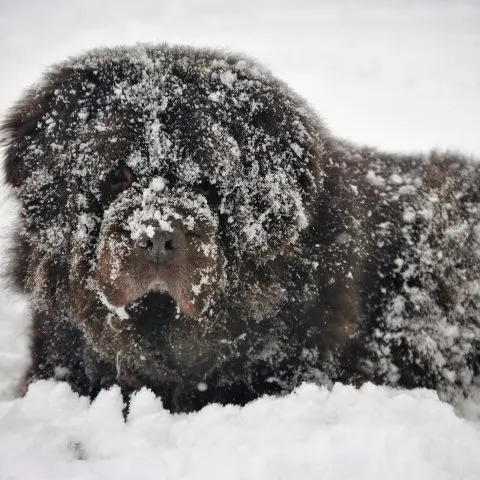
My Brown Newfies is a participant in the Amazon LLC Associates Program, an affiliate advertising program designed to provide a means for sites to earn advertising fees by advertising and linking to Amazon.com
We recommend not pulling out snowballs by hand or letting your dog chew them out.
Pulling and chewing the snowballs will pull the hair which can be painful and cause more irritation to the paws.
The more moisture that gets to the skin, the more likely it is for a dog to get yeast or bacterial infection.
It is advised to remove the snowballs from your dog’s paws as soon as possible to prevent infection or even frostbite.
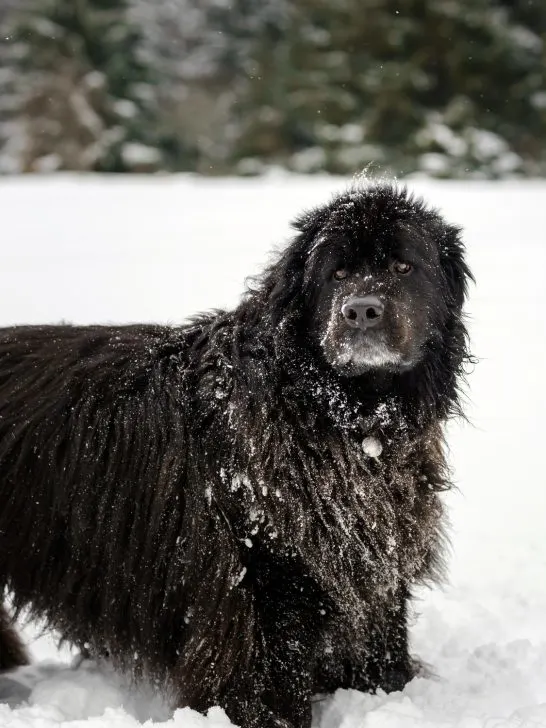
Here are 4 easy ways to combat snowballs on dog paws
Snowballs are inevitable in the winter but thankfully there are several ways that dog owners can help minimize the number of snowballs that accumulate on their dog’s legs, coat and paws.
- Keep the hair on your dog’s paws trimmed
- Invest in dog boots
- Use paw balm
- Warm water
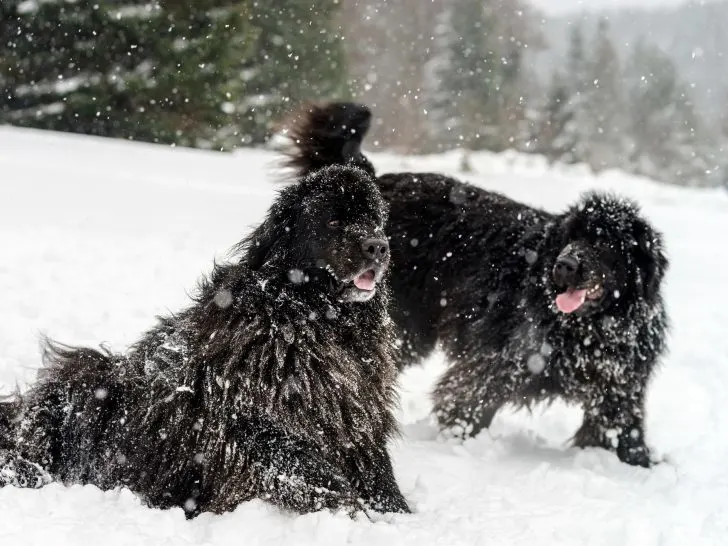
Trimmed Paws and Nails
We know that snow and ice stick to dog hair but since we can’t completely eliminate the hair, it’s important to keep it neatly trimmed.
One way to keep snow from sticking to your dog’s paws, neatly trimmed hair on the top and bottom of the paws will cut down on snowballs that build up on your dog’s paws.
The snow will have less hair to stick to thus creating fewer snowballs on the dog’s paws.
For Newfies, and other long-hair breeds, we recommend digging into your grooming tools and using thinning shears or straight shears to trim the paws.
You can also use a mini pet clipper too!
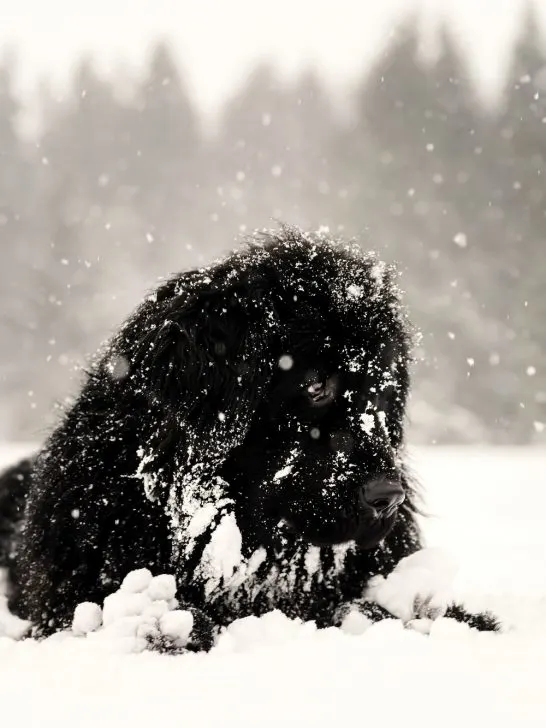
Thinning shears can be used for the top part of the paw and for the bottom, you can use straight or thinning shears.
Keeping your dog’s nails trimmed will also cut down on places for snowballs to get stuck.
The underneath of a long nail is a perfect spot for ice balls and snow to get stuck under so make sure that your dog has a good manicure throughout the winter season.
When trimming your dog’s paws to reduce snow accumulation, make sure that you don’t trim all the dog fur!
Your dog still needs some protection from the elements.
If you have a dog that has a thick double coat and long hair on the legs, you can trim those up nicely also.
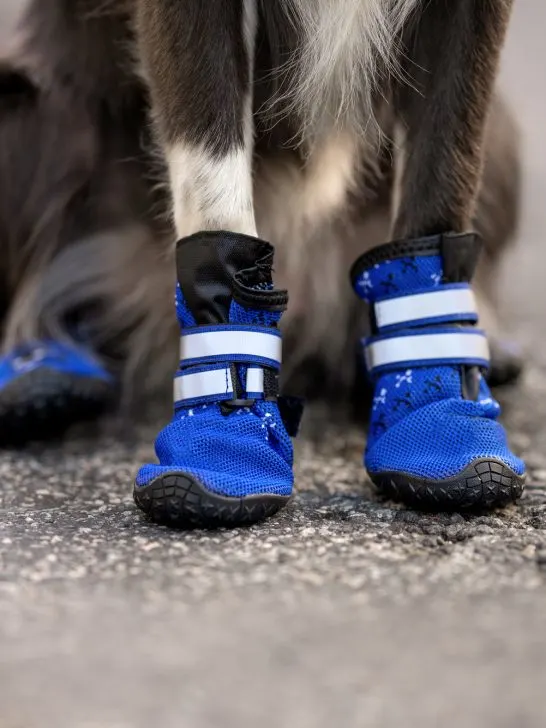
Dog Boots
Dog boots are a great way to combat snowballs on dog paws.
They come in a variety of sizes and easily slide on the paws of most dogs.
We use MuttLuks here but PAWZ boots are also used by many dog owners.
The downfall with using dog boots to combat snowballs on dog paws is that most dogs don’t like wearing them and some won’t even walk with them on.
Give your dog some time to get used to wearing before you send them out in the snow and reward them well!
Also, make sure that you measure your dog’s paws before buying and using the protective boots.
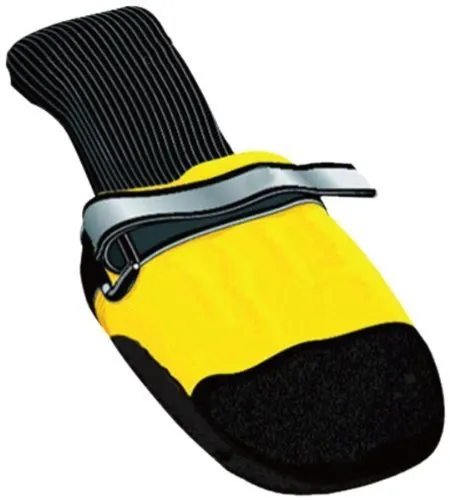
Paw Balm
Paw balm or paw wax is a great way to protect your dog’s paws from snow from ice.
This is our personal choice for battling snowballs.
The balm will protect a barrier between the hair on the paws and the snow so the snow won’t collect in between the pads and on the hair.
You can buy Mushers Secret paw balm online or in many retail stores or you can use bag balm.
There are also many DIY paw wax recipes online that you can make right from your own home with few ingredients and it does not leave paw stains on your floor.
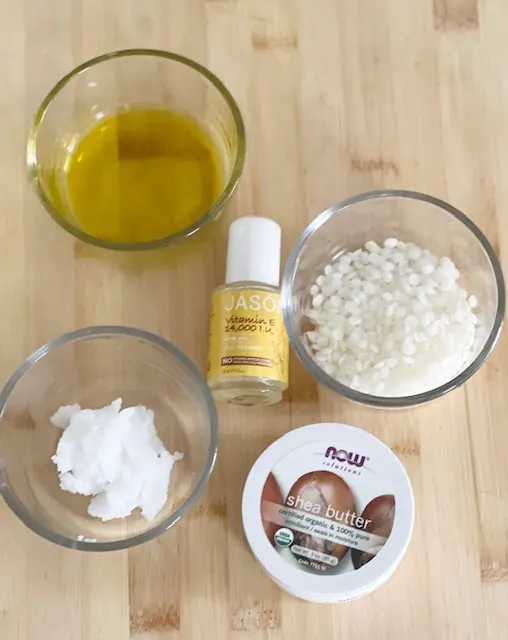
When you have the paw balm of your choice simply apply some to all 4 of your dog’s paws before heading outside.
Make sure you do this right before you head outside or they will be slipping and sliding through your house if you have laminate floors.
I’ve heard many people also use Vaseline or non-stick spray Pam on paws but this didn’t work well when I tried it and it actually made their paws slick on ice.
An added bonus of using paw balm on your dog’s paws before heading outside in the winter is that it also helps to protect their paws from dangerous ice melt.
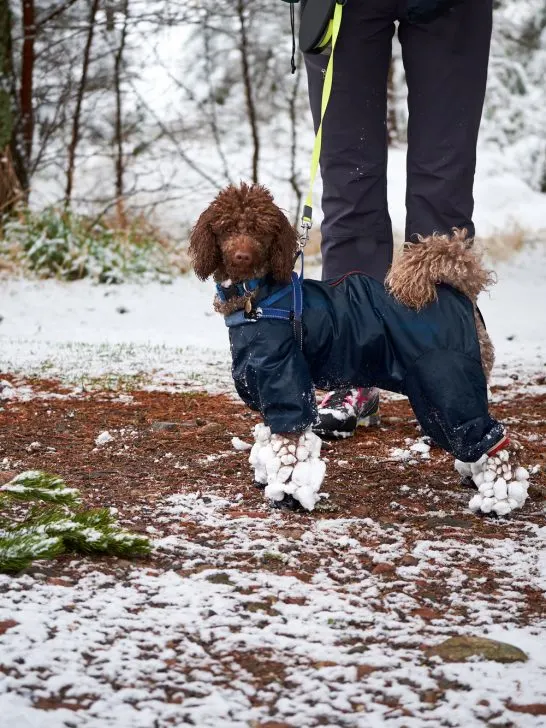
A Bowl of Warm Water
If you don’t want to deal with any of the above, a plastic bowl or bucket of warm water will also work well to remove snowballs from dog paws.
Keep a bowl by the door and fill it with warm water when your dog heads outside or use your DIY Muddy Paw Wash Station as a snowball remover!
When they are ready to come back in simply dip each paw individually in the bowls and then gently dry with a towel.
The snowballs will melt away fast!
We recommend making sure that you’re checking your dog’s paws regularly in the wintertime to make sure there is no cracking, bleeding or infection.
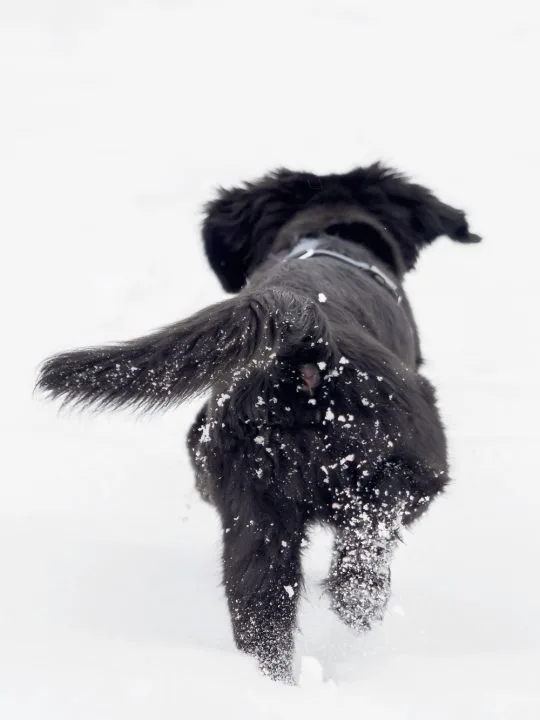
Other Ways To Protect Your Dog’s Paws In The Winter
- Dog pants
- Dog snowsuit
- Slicker brush
- Use a wire whisk
- Use a dog dryer
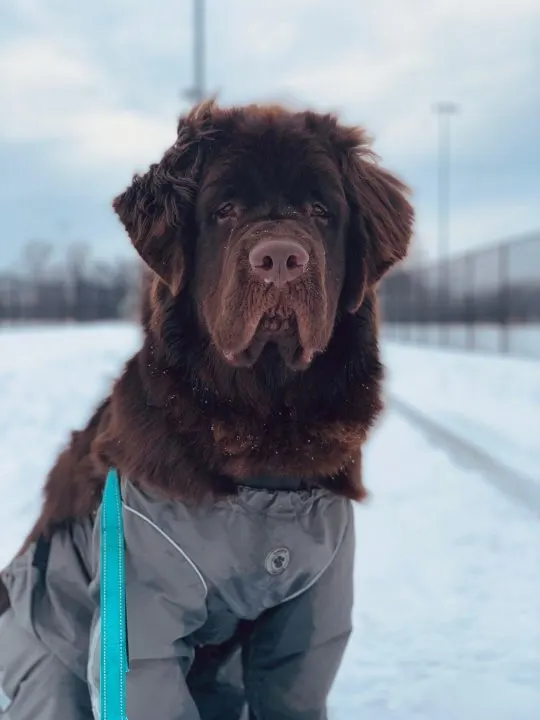
Dog pants
If you’re looking to combat snowballs on your dog’s legs, undercarriage, and chest, check out some dog pants!
Dog pants are protective gear that will help keep snowballs from clinging to your dog’s fur!
Alternatively, you can try a full snowsuit for your dog.
We like the Hurtta Snowsuits because they come in large sizes
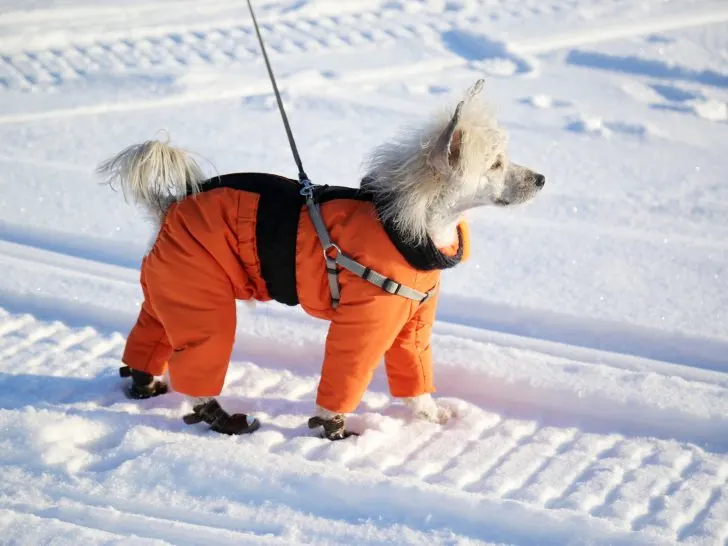
Slicker brush
If putting pants on your dog isn’t their thing then you can use a slicker brush and gently run that through your dog’s coat to remove snowballs.
I’m not a huge fan of using slicker brushes (it’s just a texture thing for me) but I do use them during the snowy months to remove snowballs and iceballs from the Newfie’s leg hair.
You can use some grooming spray with the slicker brush and just glide it over the icy fur.
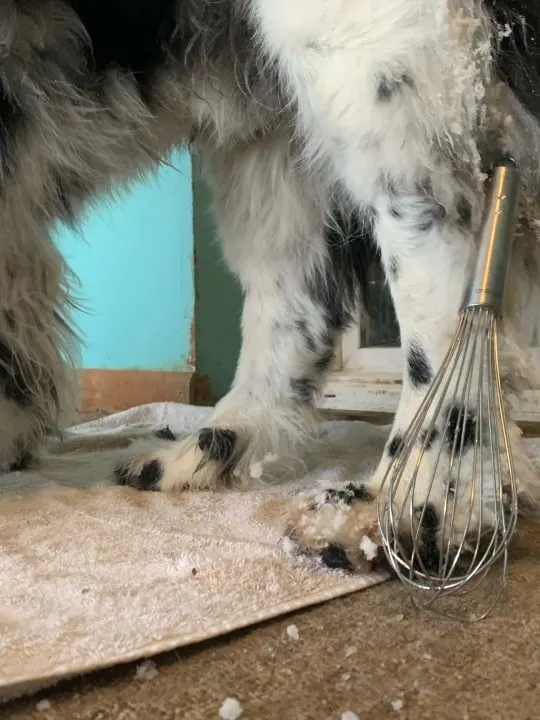
Wire whisk
A new hack many owners have also been using to remove snowballs from their dog’s legs and chest has been using a simple kitchen tool, a whisk.
You read that right, a kitchen whisk.
Simply run the whisk over the snowballs stuck on your dog’s hair several times and the snowballs drop off.
I did try this magic trick last year and it worked pretty well on the legs and belly but only with ice balls.
It did not work well for us with heavy wet snow.
I would recommend doing this gently on dogs with long hair so that the hair doesn’t get tangled and matted and definitely use a towel or rug to catch the falling balls!

Dog dryer
A high-velocity dog dryer is an effective way to get the snow off of dogs that are completely covered with snowballs.
I’ve seen a few sources recommend a regular human hair dryer but I definitely would proceed with caution.
A regular dryer gets hot and dog paws and other areas that snowballs form on dogs can be sensitive.
The last thing you want to do is burn their skin or paws with a hot dryer.
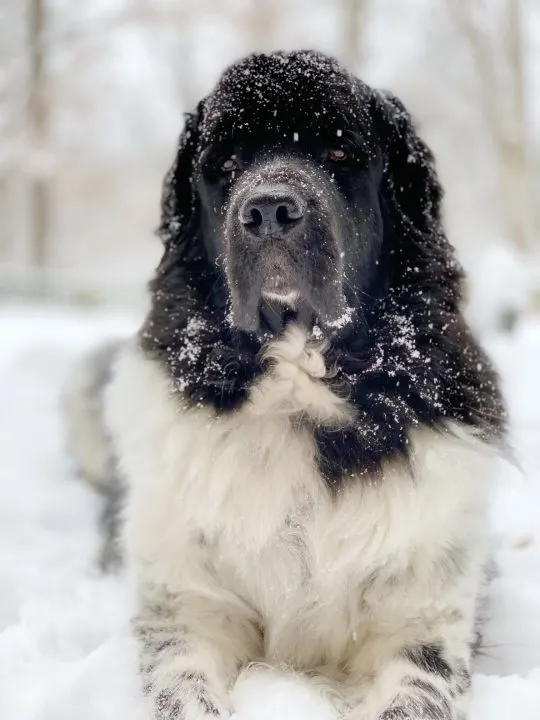
I use our high-velocity dog dryer to blast the snow off sometimes.
I like using this method for really heavy and wet snow because it also gets my dogs dry!
One last snowball-removing hack for dog parents is to use a grooming spray or dog hair detangler spray like The Stuff.
This repels dirt, dust and urine by providing a protective barrier.
It’s not made for paws but it works on the legs, chest and belly,
Snow is the best time of the year for many dogs, but they do need to be protected from some of the harsh elements that winter brings with it.
Preventing snowballs and ice balls from forming on their paws is an important area for dog owners to be prepared for.
Finally, always make sure that you’re checking your dog’s paws periodically throughout the winter.
All the moisture from the wet ground creates a perfect breeding ground for yeast and bacteria to grow.
I have Douxo Wipes that our vet gave us on hand just in case of any paw flare-ups.
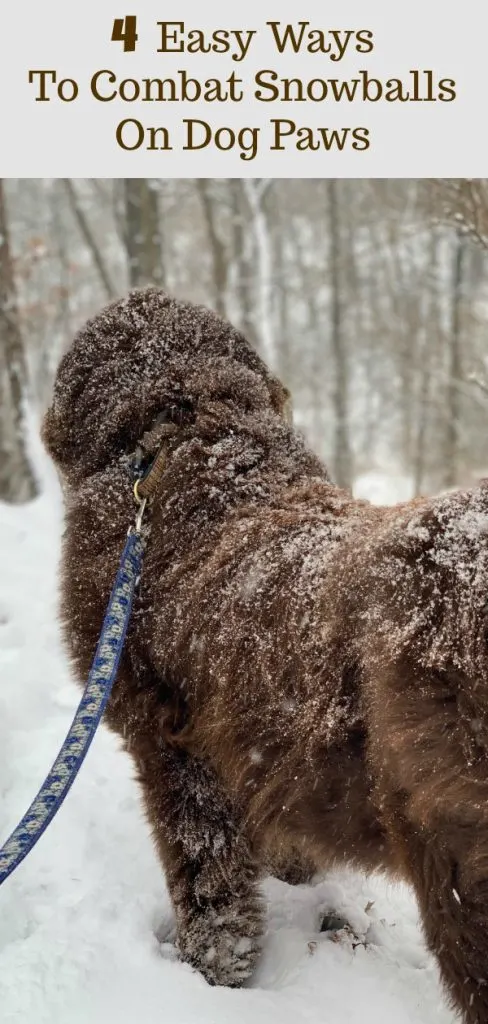
Rachel
Friday 8th of February 2019
Awesome ideas! My Golden gets these a lot in winter!
Cathy Armato
Thursday 7th of February 2019
I didn't realize how bad snowballs on paws could be for them. I'm moving the paw wax to the door so I don't forget to put it on as we get snow this Winter. Thanks for sharing these great tips. Love & Biscuits, Dogs Luv Us and We Luv Them
Sue, Shadow, and Ducky
Sunday 3rd of February 2019
We haven't had any snow here yet; but I'll definitely keep this in mind! We don't usually stay outside all that long anyway, but I do need to trim Shadow's paws soon.
Tails Around the Ranch
Sunday 3rd of February 2019
The poodles tend to get snowballs in their paws (so did the sheepdogs) so grooming is a necessity. When the snow is really deep we have to rely on boots. Naturally they don't like them, but it keeps the balls from forming and the pads save from salted walkways.